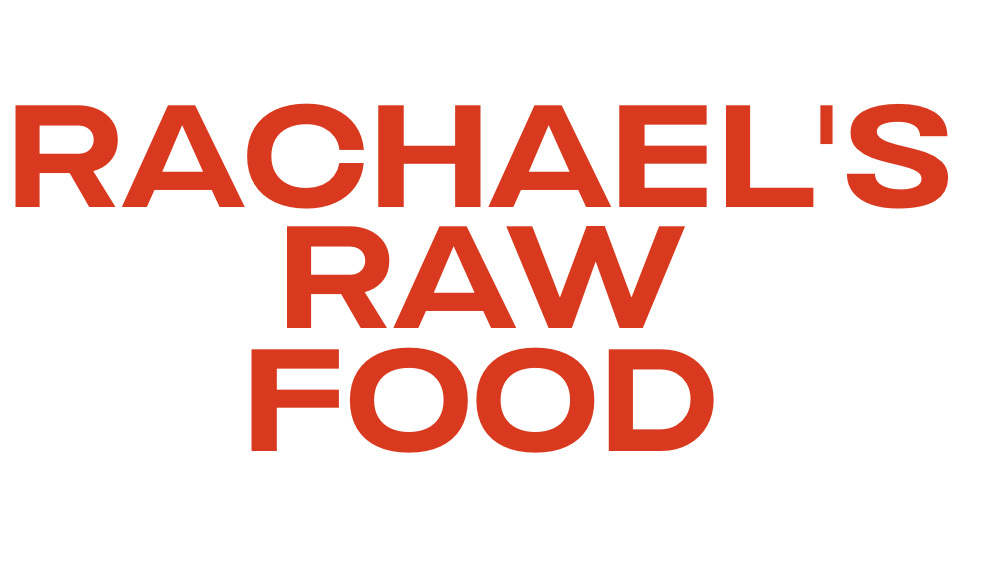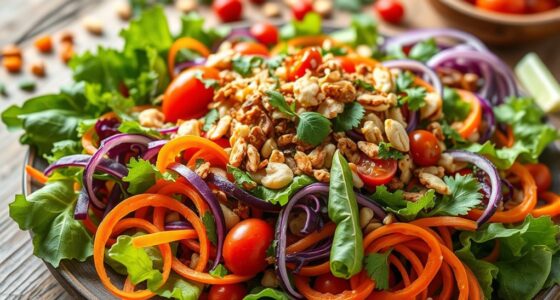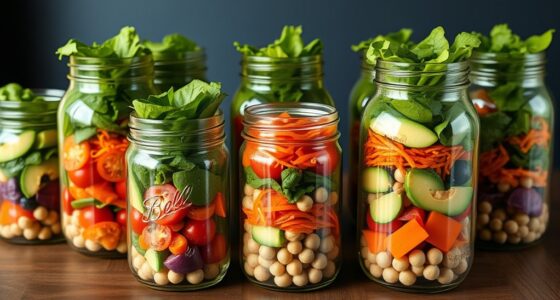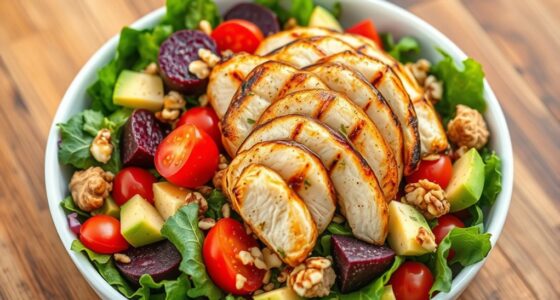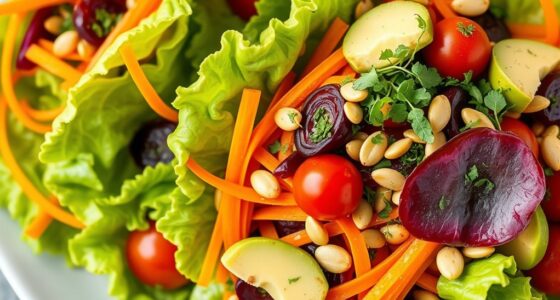To craft a rainbow on a plate, pick a variety of colorful fruits and vegetables like reds, greens, yellows, and purples to boost nutrient content and visual appeal. Arrange them thoughtfully, layering contrasting colors and using dark greens as a base to create an artistic look. This vibrant presentation not only excites the senses but also encourages mindful eating and better nutrient intake. Keep exploring to discover simple tips for making your raw salads more irresistible and nourishing.
Key Takeaways
- Incorporate a variety of brightly colored fruits and vegetables to maximize nutrient diversity and create a visually appealing rainbow effect.
- Arrange ingredients thoughtfully, layering contrasting colors to enhance visual interest and encourage mindful eating.
- Use green leafy bases with pops of purple, red, orange, and yellow for an eye-catching, nutrient-rich presentation.
- Ensure even distribution of colors for balanced nutrient intake and to motivate increased consumption of diverse produce.
- Focus on vibrant, fresh ingredients and artistic plating to elevate the salad from ordinary to a colorful, healthful masterpiece.
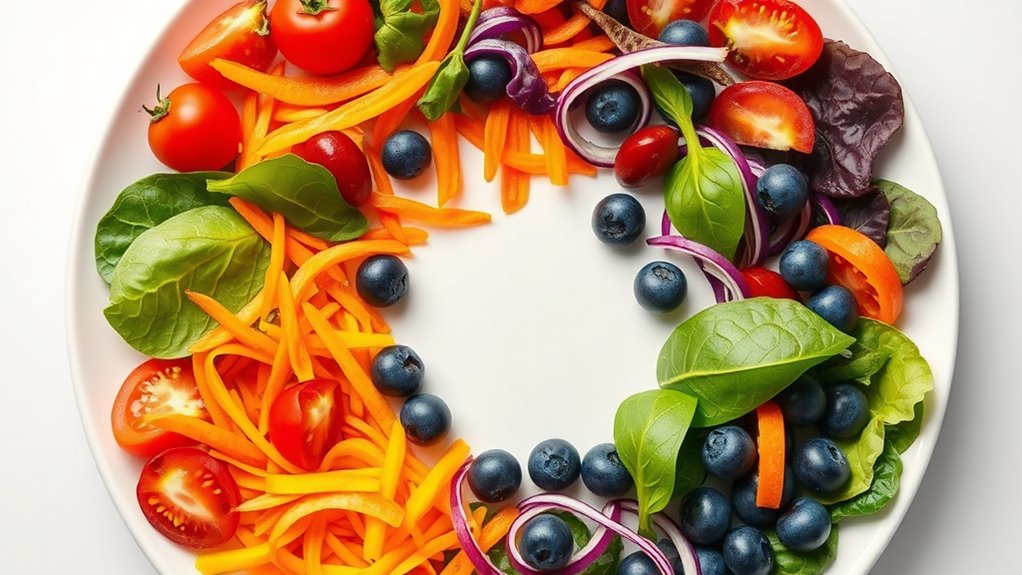
Have you ever wondered how to turn a simple meal into a vibrant feast for both your eyes and your palate? “Rainbow on a Plate” is all about incorporating a variety of colorful fruits and vegetables into your dishes, making them not only more appealing but also packed with essential nutrients. When you craft a raw salad with a spectrum of colors, you’re engaging in a form of art that celebrates food presentation. The way you arrange and combine these ingredients influences how inviting your dish appears, encouraging you to eat more mindfully. Bright reds, deep greens, sunny yellows, and rich purples create an eye-catching visual that sparks excitement before the first bite.
Color symbolism plays a significant role in how you perceive and appreciate your salad. For example, red and orange hues often symbolize energy and vitality, reminding you of ripe tomatoes, bell peppers, or carrots. Green shades, like spinach and cucumbers, evoke freshness and health, reinforcing the idea that your meal is nourishing. Purple foods such as cabbage or beets can symbolize richness and depth, adding a layer of sophistication to your plate. By intentionally selecting these vibrant ingredients, you’re not just making your salad look appealing—you’re also tapping into subconscious cues that enhance your enjoyment and motivation to eat well.
Color cues like red energize, green refreshes, purple signifies richness—enhancing both taste and motivation to eat healthily.
To maximize the impact of your raw salad, start with a clean, large bowl that allows you to arrange the ingredients thoughtfully. Think of your plate as a canvas, with each color representing a different mood or flavor. For instance, layer slices of vibrant red cherry tomatoes next to slices of yellow bell peppers, creating a striking contrast. Add dark green spinach leaves as a base, then sprinkle purple cabbage shreds for added depth. This deliberate arrangement elevates the food presentation, turning a simple mix into a work of art. When you serve your salad this way, it invites curiosity and makes the act of eating feel special. Incorporating visual appeal into your dish can also influence the way your body absorbs and utilizes nutrients, as studies suggest that presentation impacts digestion and satisfaction.
The key is balance—distribute colors evenly, ensuring no one hue dominates the plate. This not only enhances visual appeal but also guarantees you’re getting a diverse range of nutrients. The visual appeal of a rainbow-colored salad can motivate you to include more vegetables and fruits in your diet, fostering healthier habits. As you focus on color symbolism and presentation, you transform an ordinary raw salad into a vibrant, nutrient-rich masterpiece. This mindful approach to food makes every meal more enjoyable and satisfying, proving that a colorful plate can truly be a feast for all your senses.
Frequently Asked Questions
Can Raw Salads Help With Weight Loss Effectively?
Raw salads can support your weight loss goals effectively. They’re low in calories, so you can enjoy larger portions without overdoing it, especially when you practice calorie counting. Plus, salads help with portion control, making it easier to manage your intake. Filling and nutrient-dense, raw salads curb hunger longer, reducing the temptation to snack on high-calorie foods, and ultimately aiding your weight loss journey.
How Do I Store a Colorful Raw Salad?
Think of your salad as a vibrant garden needing tender care. To preserve its colorful crunch, choose the right salad container that seals in freshness, like a protective cocoon. Use freshness preservation techniques—keep it chilled, avoid excess moisture, and add dressings just before serving. This way, your salad stays crisp and bright, transforming your storage routine into a nurturing act that keeps your nutrient-packed masterpiece lively and delicious until you’re ready to enjoy.
Are There Any Vegetables to Avoid Combining?
When considering vegetable pairings, you should avoid combinations that cause flavor clashes, which can make your salad less enjoyable. Some vegetables, like cucumbers and onions, may not blend well together because of their strong flavors, while others, like beans and certain greens, might cause textural issues. Trust your taste buds and experiment with complementary flavor pairings to create a delicious, well-balanced raw salad.
What Dressings Best Preserve Nutrient Integrity?
You should choose dressings that preserve nutrients, like olive oil and lemon juice. Olive oil’s healthy fats help your body absorb fat-soluble vitamins, while lemon juice adds vitamin C and enhances flavor without degrading nutrients. Avoid heavy, processed dressings with preservatives or added sugars, as they can diminish nutritional quality. Using a simple mix of olive oil and lemon juice keeps your salad vibrant and nutrient-rich, maximizing health benefits.
How Can I Make a Raw Salad More Filling?
Imagine sinking your teeth into a vibrant, crunchy salad that leaves you satisfied. To make your raw salad more filling, add a protein boost like nuts, seeds, or beans, which help you stay full longer. Incorporate fiber-rich ingredients like shredded carrots, cucumbers, or leafy greens. These additions not only enhance texture and flavor but also keep hunger at bay, making your salad both delicious and deeply nourishing.
Conclusion
Imagine your plate as a vibrant painting, each colorful vegetable adding a stroke of health and vigor. When I first started eating rainbow salads, I felt like a painter crafting a masterpiece—each bite bursting with energy. Studies show that varied colors mean diverse nutrients, fueling your body like a well-tuned orchestra. So, embrace the rainbow on your plate, turning every meal into a vibrant celebration of health and flavor that keeps you energized and thriving.
